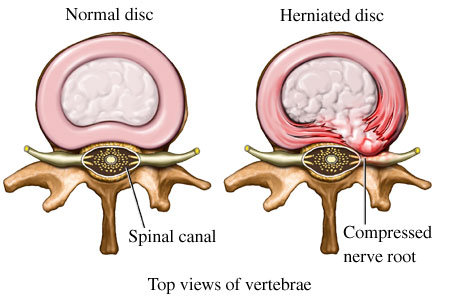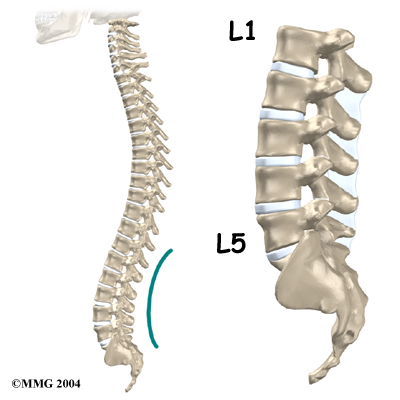In this blog, I want to talk a little bit more in depth about herniated discs, a very common condition that we see here in our office.

Image via WebMD
Above is a cross-section image of the spine, and on the right, what a herniated disc looks like. As you can see, when the disc bulges, it puts pressure on the surrounding nerves. For a more technical description, a spinal disc herniation is a medical condition affecting the spine in which a tear in the outer, fibrous ring of an intervertebral disc allows the soft, central portion to bulge out beyond the damaged outer rings. This tear in the disc ring may result in the release of inflammatory chemical mediators which may directly cause severe pain, even in the absence of nerve root compression. Disc herniations are normally a further development of a previously existing disc “protrusion”, a condition in which the outermost layers of the outer ring are still intact, but can bulge when the disc is under pressure. In contrast to a herniation, none of the central portion escapes beyond the outer layers. The condition is widely referred to as a slipped disc, but this term is not medically accurate as the spinal discs are fixed in position between the vertebrae and cannot in fact “slip”.
One of the most common symptoms of a disc herniation, and one that often results in many patients coming into our office, is Sciatica. Sciatica is a set of symptoms including pain that may be caused by general compression or irritation of one of five spinal nerve roots that give rise to each sciatic nerve, or by compression or irritation of the left or right or both sciatic nerves. Patients who come to River Ridge Chiropractic with Sciatica are often experiencing pain in the lower back, buttock, or various parts of the leg and foot. In addition to pain, which is sometimes severe, they may also be experiencing numbness, muscular weakness, pins and needles or tingling and difficulty in moving or controlling their legs. (Typically, they are only experiencing symptoms on one side of the body.) Sciatica is most commonly caused by the compression of lumbar nerves L4 or L5 or sacral nerves S1, S2, or S3, or by compression of the sciatic nerve itself. Below is a diagram of where those nerves originate.

Image via Orthopod
If you’re experiencing sciatica, there are several modalities which River Ridge Chiropractic employs to address the root cause. Typically, our Spinal Decompression Therapy is the most effective tool for addressing these symptoms. You can find out more about Spinal Decompression in the services section of our website. In next week’s blog, we’ll be taking a closer look at L5 Disc Herniation, and how it occurs.
Dr. Bart
